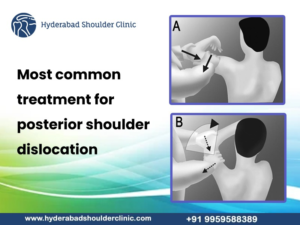The main parts of the shoulder joint are the ball and the socket. The round surface of the ball in the upper arm (humerus) into the cup-shaped socket of the shoulder blade. When this ball-shaped humerus head is displaced from the socket, it is referred to as shoulder dislocation. A shoulder dislocation can sometimes be detected simply by observing your shoulder in the mirror since the region affected often appears to be distorted by a lump.
When shoulder dislocation happens, you may experience the following symptoms:
Dislocations can hurt severely. When the humerus head is knocked out of your socket joint forcibly, cartilage, muscle, or other connective tissue might be damaged or torn. For example, a shoulder dislocation causes severe pain, and it becomes difficult to move your arm in some directions. The movements are very painful because the muscles around the dislocated shoulder joint become very stiff.

Along with pain, other symptoms might include:
- Nausea and vomiting
- Sweating
- Lightheadedness
- Weakness in the arm, hand or fingers
- Swelling
- Bruising or redness
Some symptoms are triggered by the vagus nerve, which prevents the body from responding to adrenaline. Sometimes, this can lead to fainting or passing out (vasovagal syncope).
When shoulder dislocation happens, you may experience the following complications:
A recurrence of shoulder dislocation is the most common complication. This is because the cartilage and the ligaments around the bones are stretched and damaged during the dislocation. A teenager’s age also plays a role in recurrence; 90% of teenagers suffer dislocations again after the first time.
Fractures are another common complication after a dislocation. A dislocated shoulder can also cause rotator cuff tears, and the likelihood of this complication is higher with age. In patients aged 40 years or older, 30-35% of patients are at risk for this complication. Therefore, when middle-aged patient has difficulty returning to their regular activities following shoulder dislocation, they should be evaluated for rotator cuff tears.
It is rare for patients to experience vascular injuries after a shoulder dislocation, but they may occur, and older patients are particularly susceptible. An inferior dislocation is more likely to cause vascular injuries, which usually damages the axillary artery. The likelihood of nerve injuries is greater than that of vascular injuries in anterior and inferior shoulder dislocations.
There are two ways in which the axillary nerve can be injured: it can be compressed between the humeral head and near the scapular border, or it can be damaged due to the pressure from the humeral head. Around 33% of acute anterior dislocations result in axillary nerve injury.

When your shoulder gets dislocated, you should not move your shoulder or try to reposition it to its place until you visit a doctor. When the shoulder is pushed back into the joint, there is a risk of damaging the nerves, blood vessels and surrounding muscles. Recovery takes just a few weeks after treatment when a shoulder dislocation is relatively simple without any significant damage to the nerves or tissue. However, you are more prone to dislocations in the future. Take adequate rest. If you continue to overuse your shoulder too soon after dislocation, it may result in injury.
To know more about shoulder dislocation and its treatment, consult Dr Chandra Sekhar, one best orthopaedic shoulder surgeons in Hyderabad.





